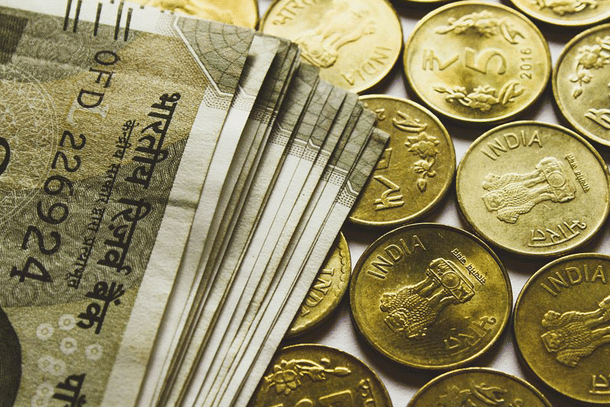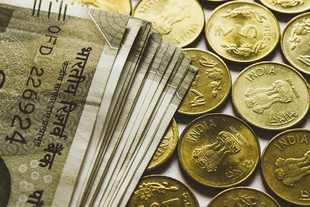Economics
Explained: Why The Devaluation Of Indian Rupee Is Not Alarming
Vibhu Vikramaditya
Jul 01, 2022, 05:40 PM | Updated 05:40 PM IST
Save & read from anywhere!
Bookmark stories for easy access on any device or the Swarajya app.


The Indian rupee has slipped against the US dollar yet again, registering an 18 paise to close at a record low of 79.03 during trading. This is one more in a sequence of events that have eroded the international purchasing power of the Indian rupee.
As the mood of financial markets and their many commentators swing, it is crucial to examine the cause of the rupee’s fall, in order to understand it and implement the correct solutions.
The macroeconomics of devaluation
The dollar is currently the world’s reserve currency. This means that currency markets value each country’s currency in relation to the dollar. The falling value of the rupee could therefore set off alarms, but this would be as misleading as interpreting the sound of falling water from a neighbour’s hose as the sound of a rain shower.
The US economy today is suffering from startling levels of both monetary and price inflation; prices rose by a historic 8.6 per cent in May breaking its 40-year high mark. The gravity of the situation is such that President Joe Biden has himself met with Jerome Powell, chair of the Federal Reserve, and has expressed sympathy for price inflation woes (while ignoring monetary inflation completely).
The Federal Reserve, acting as the central bank of the United States, is tasked with the mandate of price stability and full employment. Today, tackling and reducing inflation has become its primary goal in light of these historical inflation levels.
In an interconnected global economy, the actions of the US Federal Reserve can have major effects on the currencies of other countries. Beginning in May 2020, the Indian rupee had generally traded below the upper boundary of 75.99 till February 2022. The continued price inflation in the US economy prompted the Fed to increase its federal fund rate in February 2022 for the first time since 2018 by 0.25 basis points (from 0.08 to 0.33 per cent).
Rising US interest rates cause higher financial capital outflows from India, which lead to a fall in the value of the rupee. When the Federal Reserve increases its interest rate, dollar-based bonds at the higher interest rates become a safe haven for higher returns to all foreign institutional investors (including those in India) like hedge funds, mutual funds, pension funds, insurance bonds, high-value debentures, and investment banks from India, which means capital outflows.
The increased demand for dollars makes Indian investors sell rupees in the international currency markets, which lowers the value of the Indian currency. While this decrease in the rupee’s value does have adverse effects in terms of rising import bills and unfavourable trade balances, it can also provide benefits, which is predominantly the case today in the Indian economy.
The Indian economy today, and the dangers of going too far with interest rates
Between 2020 and 2021, India experienced a significant number of job losses and a decline of regular household income during the Covid lockdown period. GDP growth fell continuously for eight quarters. GDP growth was 8.2 per cent in March 2018 and had fallen to 3.1 per cent in March 2020.
Later, as the impact of Covid cases fell and lockdowns eased, the Indian economy showed a resilient recovery where its real GDP grew by 8.7 per cent for FY22 (ending 31 March 2022).
Much of this recovery was due to the entrepreneurial efforts of various Micro, Small, and Medium Enterprises (MSMEs). According to MSME Ministry data, there are around 6.3 crores (63 million) MSMEs in India which contribute approximately 29 per cent of the country’s GDP and are responsible for around 48 per cent of the country’s total exports.
They are also accountable for one-third of India’s manufacturing output through their national and international trade. When a country’s currency is devalued, its goods are cheaper to foreign buyers, resulting in higher exports.
This was indeed the case as India’s merchandise exports soared to a record high of $417.81 billion during FY 2021-22, surpassing the government’s target of $400 billion. The export growth was mainly driven by a surge in demand for products like petroleum, cotton yarn, textiles, chemicals, and engineering goods due to relatively cheaper Indian goods after the devaluation.
The decreasing value of the Indian rupee also creates favorable conditions for domestic demand growth, as imports become more expensive than domestic produce. This correlates with the reduction in the value of the rupee from an average of 69 rupees per dollar in 2019 to 73.5 in 2021, and 75 for the first 3 months of calendar 2022.
Therefore, because a falling rupee against the dollar is not automatically harmful to the Indian economy, raising interest rates in order to combat capital outflow could seriously damage the economy.
Most small businesses operate within small profit margins, where the cost of borrowing is significant. When the Reserve Bank of India (RBI) increases the rate at which it lends funds to commercial banks, they, in turn, pass these increased rates onto its consumers, which include MSMEs.
The reduction of margin for MSMEs, as well as the general scarcity of money in the market due to the tight monetary policies, will cause producers to lower their output. This reduction means firms must lay off some employees.
A significant portion of the micro, small and medium-scale businesses need credit to start production. Today, the surge of credit to MSMEs effectively demonstrates that economic expansion is taking place despite a rise in price inflation and expectations around it.
A monetary strategy that aims to restore the international value of the rupee primarily through interest rate measures runs the risk of starting a recession if unemployment rises, and increased prices kill consumer demand.
It thus becomes essential to explore other options which might stabilise the economy (i.e. reduce inflation) without hurting it. Foreign reserves have been accumulating since the Covid period when India’s exports exceeded imports; deploying these foreign reserves is one such option.
India’s foreign exchange reserves were of the order of $601.1 billion as of 3 June 2022, and are further supplemented by a healthy level of net forward assets held at the RBI.
The RBI, working in tandem with the Indian government, could buy rupees on the market with its massive foreign reserve, and stabilise the currency without hurting the economy with interest rate increases.




